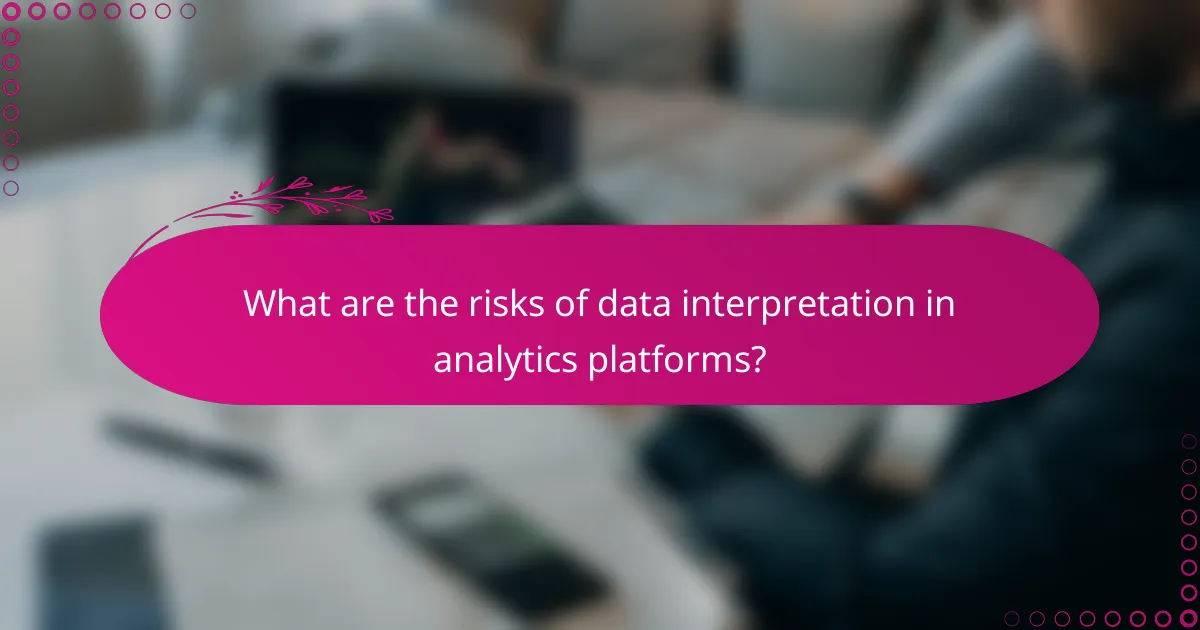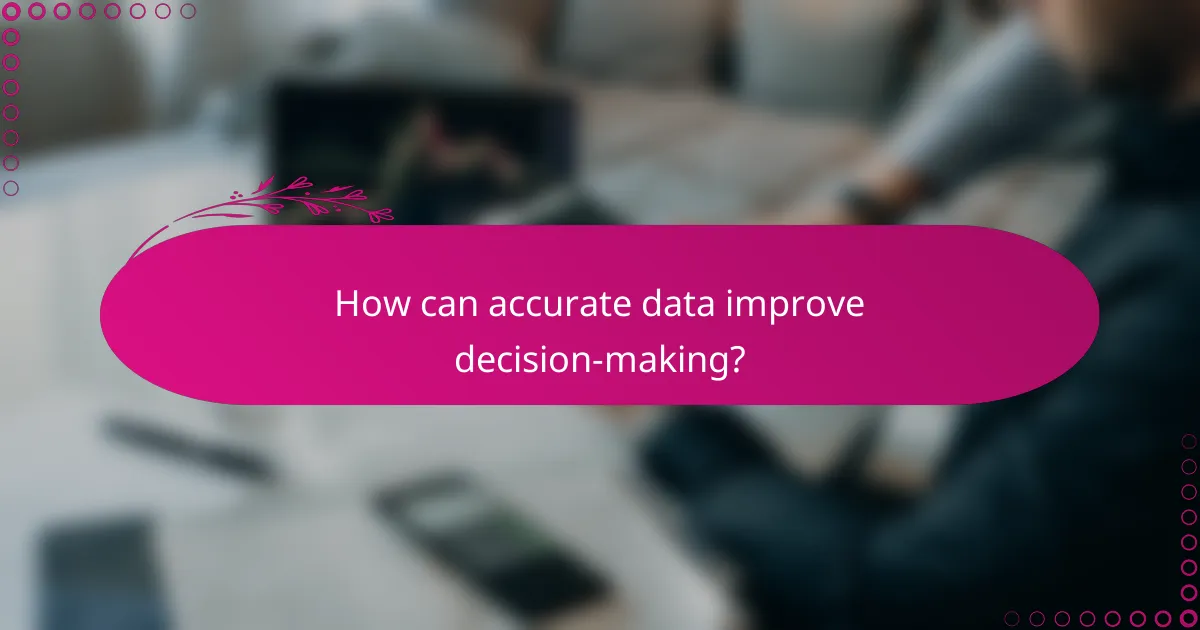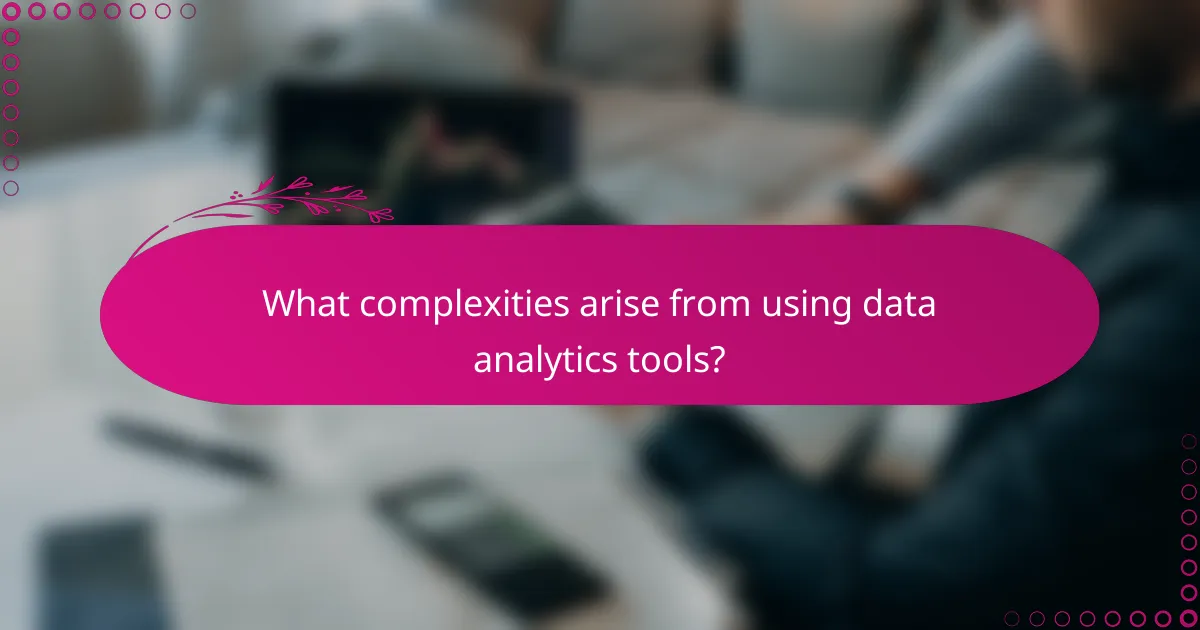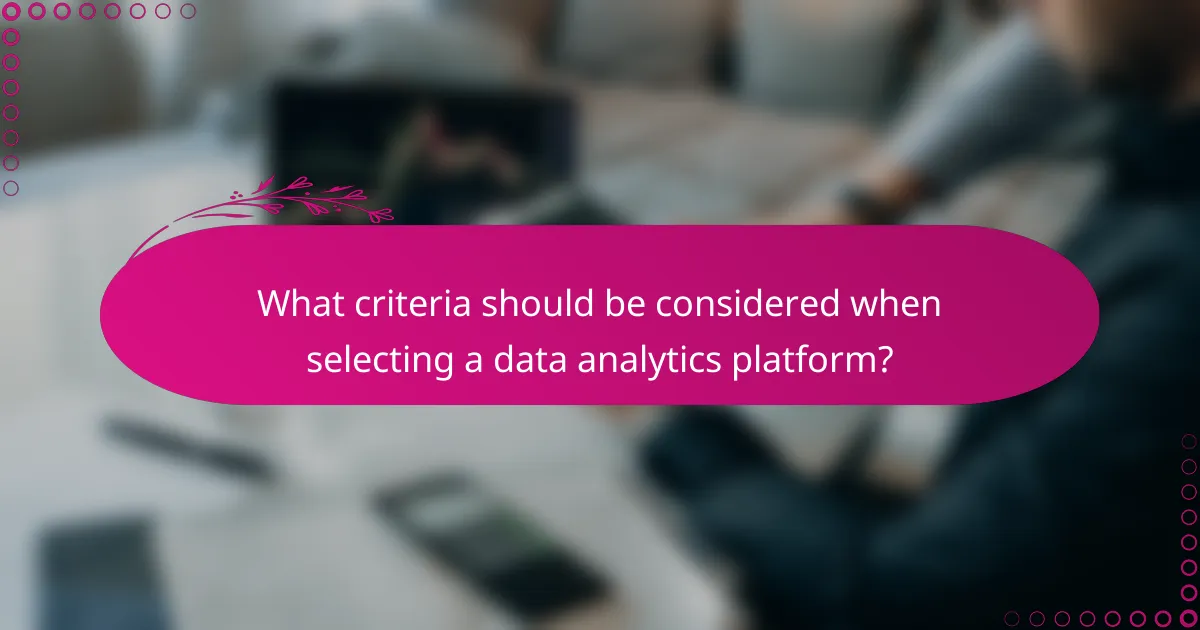Data analytics platforms offer valuable insights for decision-making, but they come with inherent risks related to data interpretation. Misleading conclusions, data biases, and an over-reliance on automated tools can compromise the accuracy of insights. Additionally, the complexity of these tools, including integration challenges and steep learning curves, can further complicate the effective use of data analytics.

What are the risks of data interpretation in analytics platforms?
The risks of data interpretation in analytics platforms primarily stem from the potential for misleading conclusions, inherent data biases, and an over-reliance on automated tools. Understanding these risks is crucial for making informed decisions based on data analytics.
Misleading insights
Misleading insights can arise from incorrect data analysis or misinterpretation of results. For instance, a correlation between two variables does not imply causation, which can lead to erroneous conclusions. It’s essential to critically evaluate the context and methodology behind the analytics to avoid drawing false insights.
Regularly reviewing the assumptions and models used in data analytics can help mitigate this risk. Employing multiple analytical approaches can also provide a more comprehensive view and reduce the likelihood of misleading insights.
Data bias
Data bias occurs when the data collected is not representative of the larger population, leading to skewed results. This can happen due to sampling errors, selection bias, or even the way questions are framed in surveys. For example, if a survey only targets a specific demographic, the insights may not apply broadly.
To combat data bias, ensure diverse data sources and apply techniques like stratified sampling. Regular audits of data collection methods can help identify and correct biases before they affect decision-making.
Over-reliance on automated tools
Over-reliance on automated tools can lead to a lack of critical thinking and understanding of the data. While these tools can process large volumes of data quickly, they may not account for nuances that a human analyst would notice. For example, automated systems might overlook outliers that could significantly impact results.
To avoid this pitfall, it’s important to complement automated analytics with human oversight. Analysts should regularly validate the outputs of these tools and maintain a hands-on approach to interpreting data, ensuring that insights are accurate and actionable.

How can accurate data improve decision-making?
Accurate data enhances decision-making by providing reliable insights that guide strategic choices. When organizations base their decisions on precise information, they can minimize risks and optimize outcomes across various operations.
Enhanced forecasting
Accurate data significantly improves forecasting by allowing organizations to identify trends and patterns more effectively. For instance, businesses can analyze historical sales data to predict future demand, leading to better inventory management and reduced stockouts.
To enhance forecasting accuracy, companies should regularly update their data sources and employ statistical models that account for seasonality and market fluctuations. Utilizing tools that integrate real-time data can further refine these predictions.
Improved customer insights
With accurate data, organizations can gain deeper insights into customer behavior and preferences. This understanding enables targeted marketing strategies and personalized experiences, which can increase customer satisfaction and loyalty.
For example, analyzing customer purchase history and feedback can help businesses tailor their offerings to meet specific needs. Regularly reviewing customer data can also reveal emerging trends, allowing companies to stay ahead of the competition.
Reduced operational costs
Accurate data helps in identifying inefficiencies within operations, leading to reduced costs. By analyzing performance metrics, organizations can pinpoint areas where resources are being wasted and implement corrective measures.
For instance, a company might discover that certain processes are taking longer than necessary due to outdated practices. Streamlining these processes based on accurate data can lead to significant cost savings and improved productivity.

What complexities arise from using data analytics tools?
Using data analytics tools can introduce several complexities, including integration challenges, steep learning curves, and data security concerns. These factors can impact the effectiveness of data interpretation and the overall reliability of insights drawn from the data.
Integration challenges
Integrating data analytics tools with existing systems can be difficult due to compatibility issues and varying data formats. Organizations often face obstacles when trying to consolidate data from multiple sources, which can lead to incomplete or inaccurate analyses.
To mitigate integration challenges, it’s essential to assess the compatibility of tools with current infrastructure before implementation. Establishing clear data governance policies can also help streamline integration processes and ensure data consistency.
Steep learning curves
Many data analytics platforms come with complex functionalities that require significant training for users to navigate effectively. This steep learning curve can delay the adoption of tools and hinder teams from leveraging data insights promptly.
Providing comprehensive training and ongoing support can help users become proficient more quickly. Additionally, selecting user-friendly tools with intuitive interfaces can reduce the time needed for teams to become comfortable with the software.
Data security concerns
Data analytics tools often handle sensitive information, raising concerns about data security and compliance with regulations such as GDPR or HIPAA. Organizations must ensure that their chosen platforms have robust security measures in place to protect against data breaches.
Implementing strong access controls, regular security audits, and data encryption can help safeguard sensitive information. It’s also crucial to stay informed about the latest security standards and best practices to maintain compliance and protect organizational data.

What criteria should be considered when selecting a data analytics platform?
When selecting a data analytics platform, consider factors such as scalability, integration capabilities, and support availability. These elements are crucial for ensuring the platform meets your organization’s current and future data needs effectively.
Scalability options
Scalability refers to the platform’s ability to handle increasing amounts of data and user demands without sacrificing performance. Look for platforms that offer flexible scaling options, such as cloud-based solutions that allow you to adjust resources based on your needs.
Consider whether the platform can accommodate both vertical scaling (adding more power to existing resources) and horizontal scaling (adding more resources). A good practice is to choose a platform that can seamlessly scale up or down as your data requirements evolve.
Integration capabilities
Integration capabilities determine how well the analytics platform can connect with other tools and systems in your organization. A platform that easily integrates with existing databases, CRM systems, and third-party applications can streamline your data workflows and enhance overall efficiency.
Evaluate the range of APIs and connectors available with the platform. Ideally, it should support popular data sources and allow for custom integrations, enabling a cohesive data ecosystem that maximizes the value of your analytics efforts.
Support and training availability
Support and training are essential for maximizing the effectiveness of a data analytics platform. Ensure that the provider offers comprehensive support options, including live chat, email, and phone assistance, as well as a robust knowledge base.
Training resources should be readily available, such as tutorials, webinars, and documentation. Consider platforms that offer personalized training sessions to help your team quickly become proficient in using the tools effectively.

How do Australian businesses leverage data analytics platforms?
Australian businesses utilize data analytics platforms to enhance decision-making, improve operational efficiency, and gain competitive advantages. By analyzing large datasets, companies can uncover insights that drive strategic initiatives and optimize resource allocation.
Industry-specific applications
Data analytics platforms are tailored for various industries in Australia, including retail, healthcare, and finance. In retail, businesses analyze customer behavior to personalize marketing strategies, while healthcare providers use data to improve patient outcomes and streamline operations. The finance sector relies on analytics for risk assessment and fraud detection.
Moreover, industries like agriculture leverage data analytics for yield prediction and resource management, helping farmers make informed decisions based on weather patterns and soil conditions. This targeted approach allows businesses to maximize their investments and minimize waste.
Case studies of successful implementations
One notable case is a major Australian supermarket chain that implemented a data analytics platform to track inventory levels and customer preferences. By analyzing purchasing patterns, they optimized stock levels, reducing waste by a significant percentage and increasing customer satisfaction.
Another example is a healthcare provider that adopted analytics to monitor patient data in real-time. This led to improved treatment plans and reduced hospital readmission rates, demonstrating the potential of data-driven decision-making in enhancing patient care.

What emerging trends are shaping data analytics in Australia?
In Australia, emerging trends in data analytics focus on advanced technologies, increased automation, and a growing emphasis on data governance. These trends are transforming how businesses interpret data, ensuring that insights are both actionable and reliable.
Data interpretation risks
Data interpretation risks arise from misinterpretation of analytics results, which can lead to poor decision-making. Factors such as data quality, context, and analytical methods significantly influence these risks. For instance, relying on outdated or incomplete datasets can skew results, leading to misguided strategies.
To mitigate these risks, organizations should implement robust data validation processes and ensure that stakeholders understand the context of the data. Regular training on data literacy can also help teams interpret analytics more accurately.
Reliance on accurate data
Accurate data is crucial for effective analytics, as it directly impacts the reliability of insights. Inaccuracies can stem from various sources, including data entry errors, system integration issues, or outdated information. Businesses must prioritize data accuracy to enhance their decision-making processes.
Employing automated data cleansing tools and establishing strict data governance policies can help maintain high data quality. Regular audits and updates of data sources are also essential to ensure ongoing accuracy.
Complexity of tools
The complexity of data analytics tools can pose challenges for users, particularly those without a technical background. Many platforms offer advanced features that may overwhelm users, leading to underutilization of valuable capabilities. Simplifying tool interfaces and providing adequate training can help bridge this gap.
Organizations should consider user-friendly analytics solutions that balance functionality with ease of use. Additionally, fostering a culture of continuous learning can empower employees to leverage these tools effectively, maximizing the value derived from data analytics initiatives.
